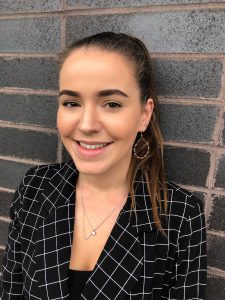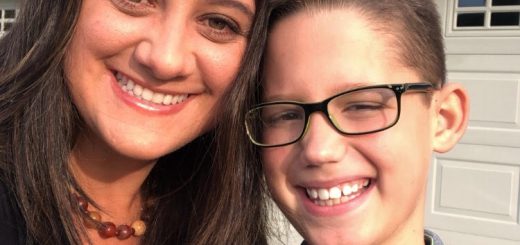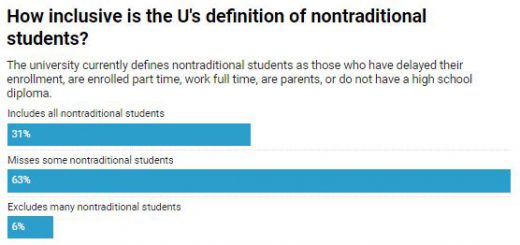Nontraditional students sometimes struggle to belong
Finding community, or even a foothold with advising, can be challenging when not pursuing a traditional four-year track.
By Becca Most, Ksenia Gorinshteyn, Dylan Anderson
For many nontraditional students who delayed education, transferred in or plan to graduate early, a question as simple as, “What year are you?” isn’t so simple.
Margaret Henke, for example, has taken more than 21 years to complete her degree in multidisciplinary studies and never knows how to properly label herself because she doesn’t fit neatly into the University’s four-year categories.
“It’s like I get stuck in a year for multiple years,” the 42-year-old said. “I’ve been in that senior-ish range for maybe two years, and before that I was a junior for maybe three years.”
Not much is simple about being a nontraditional student at the University. Their situations are, by definition, outside the norm, whether that be because of age or experience, demands of full-time work or other considerations that require them to go to school part time.
They are definitely not the student population University administrators have focused on most intently during the past few years.
“The U of M has put a great deal of energy into improving the experience for the traditional 18-22 undergraduate over the past decade,” Bob McMaster, vice provost and dean of undergraduate education, said in an email. “In large part this was a result of our poor retention and graduation rates and students leaving without a degree.
Being outside the norm affects nontraditional students in institutional and interpersonal ways — from fitting in with advising expectations, scheduling classes to complete their degrees or relating with classroom peers. Although many say they are glad to be part of the University, some nontraditional students also say the overwhelming focus on getting students through a degree in four years can sometimes make them feel as if they don’t belong.
In an AccessU Nontraditional Paths survey, where many students commented about that sense of belonging, about 23% of nontraditional students said they felt that they didn’t belong at the university compared to just 9% of traditional students.
“The lack of connection or sense of belonging to the student community makes me feel isolated,” one student wrote on the survey.
Being guided
McMaster said nontraditional students do get access to the University by transferring in or by enrolling in the College of Continuing and Professional Studies (CCAPS), where non-degree-seeking students may take regular University courses if space is available.
But in both cases, nontraditional students say they sometimes face challenges with how they are advised during their University experience.
Non-degree-seeking students, who enroll through the CCAPS aren’t formally assigned an academic adviser — although the college does have advisers available in its degree-seeking programs.
“It’s not fun to feel a little bit lost and confused because you don’t have an adviser,” said Erin Swanson, a 35-year-old nutrition student who enrolled in CCAPS after earning a previous undergraduate degree and was never assigned an adviser.
Matthew Stoffel, a 47-year-old non-degree-seeking student, said he thinks it will take him at least five years to earn his degree in multimedia production and marketing due to constraints imposed by his work schedule and his scholarship. Planning for that is tricky, he said, and an adviser would help.
Jeff Olsen Krengel, an enrollment adviser in CCAPS, said such students can turn to the college’s main office if they need help.
Other nontraditional students who have advisers say they struggle to find an adviser who can help them with scheduling that addresses their unique work, family or life experience situations. The system, they say, is more geared toward a traditional path, which sometimes doesn’t match their needs.
Luke Boudewyns, a 29-year-old transfer student majoring in global studies and environmental science, said he found it difficult to understand opportunities and deadlines that matched his trajectory. The one-day transfer student orientation, he said, gave him only cursory introduction to career-oriented resources and basically no insight into scholarship opportunities.
When he met with his adviser, he said the experience was simply a generic session tailored to high school graduates who were planning a four-year degree: The adviser told him to take 15 credits each semester with classes of his choosing. As it turned out, Boudewyns would have to take 16 to 17 credits a semester to stay on track for graduation. He took 19 this semester.
“My adviser tried his best but it really felt like I was just another number, just another student,” Boudewyns said. “I had to find a lot of the resources myself.”
Boudewyns, for one, sees this as a mindset and training issue. “They’re more tailored to traditional students that come straight from high school,” he said. “From a nontraditional standpoint, it feels like they’re more groomed for that experience.”
The University’s advising office holds multiple training sessions — on financial concerns, diversity and equity and well being — throughout the year, but some advisers say the sessions don’t include material to fit the nontraditional student, according to Danielle Dadras, the senior academic adviser of the global studies department.
“I think that they are always trying to [keep nontraditional students in mind],” said Dadras. “I think that’s absolutely part of their intention. I’m not sure that they do it very well.”
Part of the problem, she said, might be the rush advisers feel from managing a large number of students. Dadras said a University push to take notes and file summaries on each advising appointment has caused her to shorten her time with students so she can file those summaries before her next visit.
“I know there are all these reasons [for the summaries] about transparency and ensuring timely graduation and so forth,” Dadras said. “But ultimately, I think that that sort of detracts from things that are the higher-order advising pieces, like fostering a sense of belonging, listening to student challenges, hearing about where they’re having successes and where they’re not.”
She also said she and other advisers are committed to addressing the needs of all students regardless of path. In her department, she said, advisers encourage students to connect with each other via peer networks and work on listening holistically to each student during one-on-one sessions.
“You can go into an advising session and it’s really easy to just get in and get out, check these boxes,” Dadras said. “We don’t really operate like that.”
Scheduling difficulties
Nontraditional students say advising is one part of a general disconnect with the larger problem of being outside the script of university student services, which includes the ability to fit a work schedule into the expectations of traditional college life.
Scheduling does sometimes impact the ability of nontraditional students to access advising, said CLA adviser Barbara Goodwin said.
The recent transition to online because of COVID-19 has actually eased that situation, she added.
Goodwin said she’s now able to be more flexible about scheduling advising appointments online, allowing her to meet with students who work full time to meet during their lunch break, she said.
“It’s a great way to produce increased access,” Goodwin said.
But nontraditional students have faced a bigger problem fitting into scheduling requirements imposed by some of their major program classes — particularly upper division requirements needed to complete their degrees. Many of those classes are offered during the week, when many nontraditional students work.
Adam Best, a 49-year-old psychology major, works full time while being a part time student, and his day job has forced him to take evening classes.

Scheduling classes has become increasingly difficult as he has progressed through this major, he said. Because many of his required upper-level courses are only offered during the day, his adviser said he won’t be able to graduate from the University unless he misses work.
In order to complete his degree, he’ll have to go back to a community college, he said.
“It’s kind of a bummer,” he said. “I really wanted that cachet that comes with the University of Minnesota degree. It kind of went from an elation to this ahh.”
Socializing with classmates
Many nontraditional students say they do not “belong” on campus in the same way a traditional student does. Differences in age or experience can make it hard to relate to peers, and sometimes it can be difficult to find community.
Almost a third of nontraditional students surveyed by AccessU said their status as a nontraditional student had a significant drawback on their social lives.
In his psychology classes, Best said he feels a general sense of disconnection from peers who are usually half his age. Although no one has been blatantly rude or exclusionary, Best says he often has to go the extra mile to join or initiate a conversation.
“Every once in a while, it’s like talking about what you did last weekend, and you kind of see this hesitation in their eyes,” he said. “They’re talking about their work at Chipotle, and I’m talking about my work with Exxonmobil. There’s just a disconnect there, and it’s not anybody’s fault, it’s just the way it is.”
With limited parking on campus, he has found it difficult to attend on-campus events like football games or parties. He hasn’t even been able to attend on-campus activities designed for transfer students at the beginning of the year because they were scheduled during the day, when he works.
“For once in my life I wanted to have that [college] experience,” he said. “You know, going across the quad, sitting in a big classroom, going to athletic events … I feel like I’m missing out.”
Hallie Osmon, 21, a part-time journalism student who transferred to the University from St. Olaf, said she doesn’t have the time or desire to engage with others in her classes. Before COVID-19 she was working 30 hours a week at a bar in St. Paul in order to pay her rent and tuition.

Because of her work schedule she wasn’t able to join any clubs or get an internship related to her field of study. She has since lost her job and is trying to figure out what to do to manage financially, she said.
Osmon said that when in-person classes were in session, she treated going to class like a job, clocking in and out of class, finding most of her social life at work.
This semester had started out differently, and she began to make a few connections in classes, she said. But the cancelation of in-person classes ended all that.
“Everyone talks about U things and professors and buildings and I just don’t know anything about the U,” she said. “So I just don’t join in conversations and I always treated it kind of like a job. I show up, get it done, sit through the lecture, leave.”



